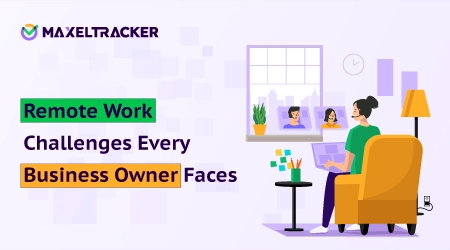

Is it really possible to monitor employee performance without slipping into micromanagement? A not-so-great manager once thought it was impossible and overwhelming. But the truth is, managers like this often don’t realize how much harm they’re causing to their employees’ mental well-being.
In simple terms, micromanagement means excessive oversight or control over employees, often crossing professional boundaries. On the other hand, there’s an equally harmful practice known as under-management, where managers completely avoid overseeing or guiding their teams to escape accountability or conflict.
Both extremes are damaging to team morale and output. That’s why finding a balanced approach to Employee Productivity tracking is essential. It allows you to stay informed and supportive without hovering or going completely hands-off.
In this blog, we’ll take a closer look at what micromanagement really is, explore the warning signs that indicate you might be doing it, and understand the negative effects it can have. We’ll also share expert tips on how to monitor performance the right way, without overstepping or checking out. Let’s dive in and learn how to eliminate micromanagement in all its forms.
Before you can address a problem, you need to understand what it is and why it negatively impacts productivity. The same goes for micromanagement. To truly improve how you lead your team, it’s important to understand why employee monitoring without micromanagement is far more effective.
Micromanagement happens when managers exercise excessive control over their employees. If you’re unsure whether you fall into this category, consider the following behaviors:
Focusing too much on minor, insignificant details
Stepping into tasks your employees are fully capable of handling
Making all the decisions without involving your team
Criticizing constantly, leaving no space for creativity or autonomy
Feeling anxious about losing control of your team
If most of these sound familiar, it's time to rethink your management style. Learning how to monitor employee performance without micromanagement is essential for building a healthy and productive workplace.
Micromanagement is far from an effective way to monitor work performance. It often does more harm than good, which is why it's important to adopt better, healthier management practices. But before you can make a change, you need to recognize the problem.
So how can you tell if you're micromanaging your team? Keep reading to identify the warning signs and understand when it’s time to shift your approach to monitoring employee performance more effectively.
One of the clearest signs you may be micromanaging is the constant need to oversee every step of your team’s workflow. It’s as if you're watching over their shoulders at all times, leaving little room for independent decision-making.
To monitor idle time without micromanagement, it’s important to let go of this excessive control. For instance, requiring your team to get approval for every draft before moving forward with a report slows down progress and shows a lack of trust. Instead, focus on guiding outcomes rather than micromanaging every step.
If you believe that no task can be trusted to others, you're likely taking on more work than necessary. This not only increases your own stress but also limits your team's growth and efficiency.
A smarter approach is to monitor employee productivity without micromanagement, giving your team the freedom to take ownership of their work and responsibilities. For example, handling tasks like scheduling a meeting on your own instead of assigning it to your assistant shows a lack of delegation. Trusting your team with such responsibilities helps build confidence and frees up your time for more strategic work.
When you spend too much time fixating on small, insignificant aspects of a project, you risk losing sight of the bigger picture. This habit not only distracts your team but also adds unnecessary pressure, which can lower overall morale.
For example, paying more attention to the font size of a report than its actual content shows misplaced priorities. Shifting your focus to the quality of work rather than the tiny details helps improve productivity and encourages better outcomes.
Managers who frequently check in with their employees throughout the day, often interrupting their work for updates or clarifications, can quickly become a source of frustration. It’s easy to see why this kind of pressure makes employees feel like they’re not trusted to do their jobs.
For example, holding several unplanned meetings in a single day just to talk about the same project can break focus and slow down progress. A better approach is to set structured check-ins that respect your team’s time and workflow.
“Who did you ask before sending that email?” If that sounds familiar, you’re not alone. This is a common example of how micromanagers unintentionally discourage their employees. It creates a cycle of self-doubt and embarrassment, making team members second-guess even the simplest actions.
Micromanagement like this can be deeply damaging to morale and confidence. That’s just one reason why it's important to monitor employee performance without micromanagement. For instance, requiring employees to seek approval for every small business purchase shows a lack of trust.
If you find yourself asking for detailed updates on tasks that don’t require close tracking, it’s a clear sign of micromanagement. These constant requests not only disrupt your team’s workflow but also lower overall productivity.
This kind of excessive reporting creates a tense work environment, where employees feel watched instead of supported. The best way to address this is by using employee monitoring methods that avoid micromanagement. For example, asking for hourly updates on routine tasks like social media posts can feel excessive and controlling. Instead, set clear expectations and trust your team to deliver results without constant check-ins.
One of the quickest ways to lose your team’s trust is by constantly redoing their work without involving them in the process. This approach sends the message that you don’t believe in their abilities, which can be demoralizing and frustrating.
Instead, it's far more effective to monitor employee performance without micromanagement. For example, if you regularly change the format of every email draft before it’s sent, you're not giving your team the opportunity to learn or grow. A better method is to provide constructive feedback and guide them toward improvement rather than taking over completely.
This issue is exactly what it sounds like. When managers bypass team leads and directly give instructions to employees, it can cause confusion and disrupt the flow of work. It also undermines the authority of team leaders, leading to frustration and a lack of clarity within the team.
This approach is not an effective way to monitor work performance. Instead, it's important to respect the structure in place and involve the right people when addressing issues. For example, directly telling a junior developer to fix a bug, especially harshly or abruptly, can stall the project and damage team morale. Clear communication through the proper channels is always more productive.
Research shows that employees in high-trust organizations experience 74% less stress, 106% more energy at work, 50% higher productivity, 13% fewer sick days, 76% more engagement, and 29% greater job satisfaction. These are powerful benefits that come from trusting your team.
Unfortunately, micromanagers often miss out on these gains because they constantly question whether employees can manage their time effectively. This can lead to practices like excessive employee time tracking, which often feel more like surveillance than support.
For example, requiring employees to report every hour of their work to a supervisor creates unnecessary pressure and disrupts focus. A better approach is to track progress based on outcomes rather than constantly monitoring every minute.
As we’ve highlighted in previous blogs, employees have lived beyond the workplace. Respecting those boundaries is essential for maintaining a healthy work culture. That’s why we strongly recommend employee monitoring without micromanagement.
Micromanagers, however, often ignore these limits. For example, calling an employee about work while they’re spending time with family at a picnic shows a lack of respect for personal time. Another common issue is sending work emails outside office hours and expecting immediate responses. These practices not only disrupt work-life balance but also lead to burnout and resentment over time.
Criticizing employees in front of their colleagues can seriously damage their confidence and motivation. It creates an environment where people feel embarrassed, discouraged, and emotionally withdrawn from their work. Over time, they may start working mechanically, without creativity or enthusiasm, which affects both productivity and mental well-being.
This is why it's so important to track employee productivity without micromanagement. For example, pointing out every small mistake in an employee’s presentation during a team meeting may seem like feedback, but in reality, it can feel like public humiliation. A more constructive approach is to provide feedback privately, in a way that encourages growth rather than fear.
Monitoring employee performance without micromanagement means valuing every piece of feedback, no matter how small. Listening to your team shows that you trust their insights and care about their experience.
Micromanagers, on the other hand, often ignore or dismiss employee input, which weakens trust and damages professional relationships. For example, brushing off every suggestion about how to improve project management sends the message that employee opinions don’t matter. Taking the time to consider feedback helps create a collaborative and more productive work environment.
Excessive employee monitoring often leads to chaos within the organization. Micromanagers tend to set deadlines that are simply not achievable. When employees fail to meet these impossible expectations, it becomes yet another reason for managers to express their frustration. For example, expecting an entire complex marketing campaign to be prepared and launched within just one week.
Strong leaders know how to delegate, especially when it comes to routine administrative work. But micromanagers often try to handle everything on their own, piling unnecessary tasks onto their plate and slowing down overall productivity. If you're constantly buried in approvals and reports, it may be time to rethink how you monitor employee performance. For example, asking for detailed timesheets, daily status updates, and repeated approval forms can quickly become counterproductive.
Requiring approval for every little decision can bring progress to a halt. Micromanagers often delay workflows by insisting on formal approvals for even the smallest actions. This approach not only wastes time but also signals a lack of trust in your team’s judgment. For instance, demanding approval for every minor expense shows you're more focused on control than efficiency.
Overloading your team with performance metrics can do more harm than good. When employees are too focused on meeting strict standards, they lose sight of the actual work. This often leads to decreased productivity and increased stress. It's a clear sign that performance monitoring needs to be more balanced and less controlling. For example, tracking employee productivity minute by minute shifts the focus from results to rigid oversight.
Constantly changing direction in a project can feel like hitting one roadblock after another. It’s frustrating and unproductive. When you manage projects without trusting your team’s flow, and fail to monitor productivity in a healthy way, it disrupts the entire workflow. As a result, deadlines get pushed further with little progress to show. For instance, frequently shifting project priorities because of minor or new issues can create confusion and delay.
Now that you’re familiar with the signs of micromanagement, it’s important to consider the consequences of continuing down that path. If you're still hesitant to adopt a more balanced approach, here’s what you’re actually doing to both yourself and your team by refusing to monitor employee performance in a more respectful, hands-off way.
One of the most important reasons to monitor employees without micromanaging is to maintain high morale. When you constantly hover over every task, it creates stress and frustration. If this continues, don’t be surprised when absenteeism rises and motivation drops.
Micromanagement often leads to a drop in productivity. After all, no one enjoys being constantly watched or corrected. When employees deal with overly controlling management, it becomes harder for them to concentrate and deliver quality results. If you truly want better output, it’s essential to monitor performance in a more supportive, less intrusive way.
When morale drops due to micromanagement, employees are more likely to leave at the first opportunity. Even a small issue can become the reason they choose to resign. As turnover increases, your organization’s reputation may suffer, and you could end up overwhelmed by trying to manage everything on your own. To avoid this, it’s better to adopt effective methods, such as using reliable employee productivity monitoring software.
When you spend all your time watching what your employees are doing—or not doing—you lose track of your own responsibilities. This constant oversight pulls your focus away from tasks that actually need your attention. A smarter solution is to rely on live screen monitoring software to handle that part, so you can stay focused on your priorities.
When you constantly manage every small detail, it eventually takes a toll on your mental and emotional well-being. This kind of excessive control can lead to unnecessary stress and burnout. Choosing a more balanced approach to employee productivity monitoring helps you protect your own energy and avoid being overwhelmed.
Creativity and innovation are essential for producing high-quality work. But when you micromanage your team, you're likely to frustrate them and create an environment where fresh ideas can't thrive. So how can you realistically expect their best work under constant pressure? Still not convinced to monitor employee productivity without micromanagement?
By now, it’s clear that monitoring employee performance without micromanagement leads to better outcomes. But if you ask someone how to stop micromanaging, you’ll probably hear a simple answer: “Just don’t micromanage.” The reality, however, is that breaking this habit takes more than good intentions.
The first step to monitoring employee productivity without micromanaging is to clearly communicate what needs to be done. Your expectations should be realistic and achievable. When employees clearly understand their goals, they can choose the most effective way to achieve them. This not only improves the quality of work but also builds trust across the team.
While micromanagers tend to schedule several meetings a day, effective managers focus on holding structured weekly or monthly check-ins. These regular meetings help track progress without overwhelming the team. It’s a practical and respectful way to stay informed and monitor employee performance without creating unnecessary pressure.
Using the right tools is essential for effective employee productivity monitoring. Time tracking, employee monitoring, project management, and productivity software like MaxelTracker can help you stay updated without interrupting daily work. Once your goals are clearly defined, these tools handle the tracking and provide accurate reports, with no need for constant supervision.
When you hold your team members accountable for their work, there’s no need for excessive management. Promoting responsibility empowers employees to take full ownership of their tasks. This approach not only reduces the need for constant oversight but also empowers your team to work more independently and confidently.
Supporting your team’s growth is a smart way to monitor performance without hovering. When you give employees access to learning resources and training, they’re better equipped to meet expectations on their own. With the right skills, they can deliver strong results without needing constant supervision.
Clear communication builds trust and sets the foundation for productive work. When employees fully understand your company’s standards, policies, and expectations, they’re more likely to stay aligned and perform well. Transparency reduces confusion, encourages accountability, and removes the need for micromanagement.
Monitoring performance doesn’t mean constantly pointing out mistakes. But it also doesn’t mean staying silent when improvement is needed. The key is to offer feedback that guides growth without damaging confidence. Constructive criticism helps employees improve while maintaining their motivation and focus.
By now, you should have a clear understanding of how to monitor employee performance without falling into the trap of micromanagement. Overmanaging not only disrupts productivity, creativity, and innovation but also damages employee morale and increases turnover. That’s why it’s crucial to recognize the signs of micromanagement early and take steps to change your approach. The good news is that you now have effective strategies to monitor your team’s work in a supportive way, one that enhances efficiency, boosts productivity, and contributes to the overall success of your organization or business.
👉 Sign up now at MaxelTracker.com and start transforming your team’s productivity today! 🚀
👉 Explore our pricing plans and features to find the perfect solution for your team’s productivity needs! 🚀
Related Blogs

12 Top Strategies for Enhancing Your Call Center Efficiency 2026
Running a call center today feels like such a big task, doesn’t it? It seems as if someone just dropped a ton of weight on your head. It is also a lot like trying to conduct an orchestra where the main drummer is on mute.

Why 21% of Billable Hours Vanish and 5 Instant Fixes That Work
Remote work is flexible, and it has transformed how your company operates, and it is true for several industries across the world. It brings access to global talent and ensures cost savings. But there’s a catch.

15 Remote Work Challenges Every Business Owner Faces — And How to Solve Them
Remote work rings a familiar bell, and it offers flexibility and global reach as well. But for CEOs, HR heads, and other important position holders across countries like USA, UK, Canada, or UAE, it is often the bringer of stress.